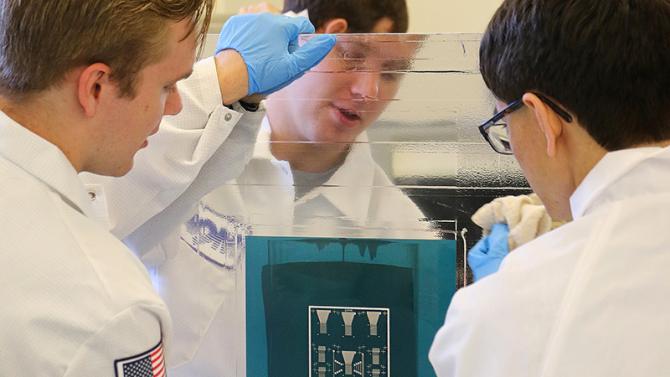Manufacturing Engineering
College of Engineering
Manufacturing engineers design, plan, develop and optimize how products are produced.
San Luis Obispo, California
The manufacturing engineering curriculum is based upon the application of the basic knowledge of math, physics and materials involved in the wide variety of manufacturing processes.
Opportunities are available for undergraduate and graduate work in many fields of interest, with the following laboratories available for course work and research projects:
- Additive Manufacturing Lab
- Advanced Computer Aided Design Lab
- Business Software Systems Lab
- Electronic Design and Manufacturing Labs
- Facilities Design and Simulation Lab
- The Gene Haas Laboratory for Robotics and Automation
- George Hoffman Industrial Systems Design Lab
- Haas Advanced Manufacturing Lab
- Haas Netshape Lab
- Human Factors and Ergonomics Lab
- Material Joining / Netshape Lab
- Material Removal Lab (Machining)
- Metrology Lab
- Undergraduate Lab
While there are no formal concentrations, you can choose to focus on areas such as:
- Automation and Robotics
- CAD/CAM
- Electronics Manufacturing
- Manufacturing Process and Design
- Manufacturing Systems
- Sustainability
- Rapid Prototyping & 3-D Printing
Manufacturing engineering majors are able to participate in a blended program where you can earn your bachelor's and master's degrees at the same time.
To be eligible for the program, you must have completed all lower-division work, including general education and American Institutions courses but before you have reached 180 unites toward your undergraduate curriculum requirement. Participation in the program is based on prior academic performance and other measures of professional promise, with a minimum GPA of 3.3.
About the Program
Manufacturing engineering is an interdisciplinary engineering program that gives you knowledge of the processes, tool design and computer-aided manufacturing used in creating products.
While the program places emphasis on engineering, math and science, it also offers opportunities to focus on the business side of problem solving in labs, internships and co-ops. Ranked as the top manufacturing engineering bachelor’s programs in California and the nation by U.S. News and World Report, it is also accredited by the Engineering Accreditation Commission of ABET.
Learn by Doing
Manufacturing engineering teaches you how to create the stages of a manufacturing system and produce products in the most time-efficient and cost-effective way possible – all while maintaining safety and product quality. You will learn how to mold and cast materials, create prototypes, use computer-aided drafting and modeling, analyze and simplify work processes and more.

Create Flexible Circuits
Our Graduates
A manufacturing engineering degree opens the door to many attractive career options in numerous industries.
Beyond manufacturing and production management, our graduates may also be responsible for inventory control, quality management and control, material flow, cost analysis, procurement and supply chain management. Many of our graduates go on to successful graduate study programs.
